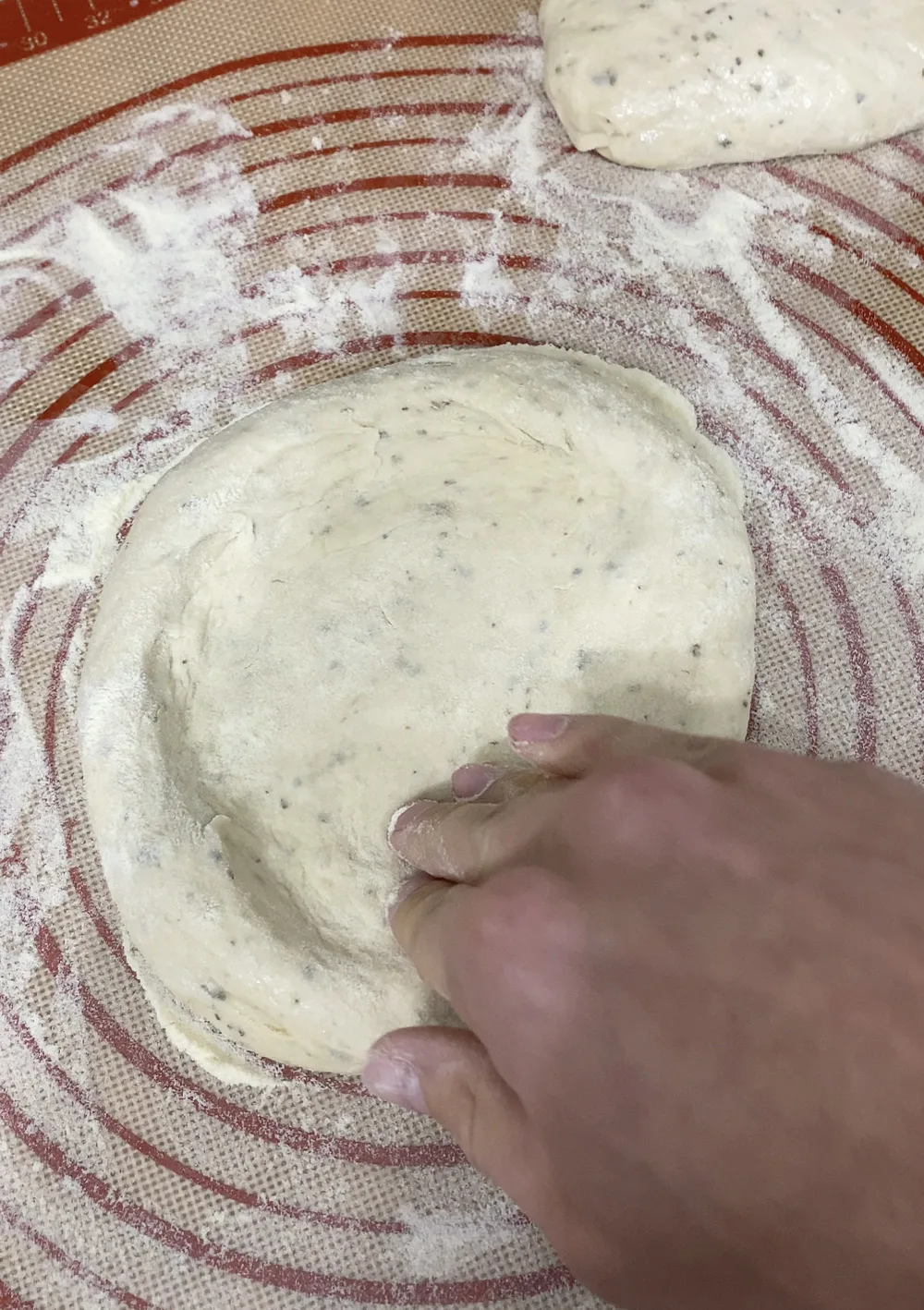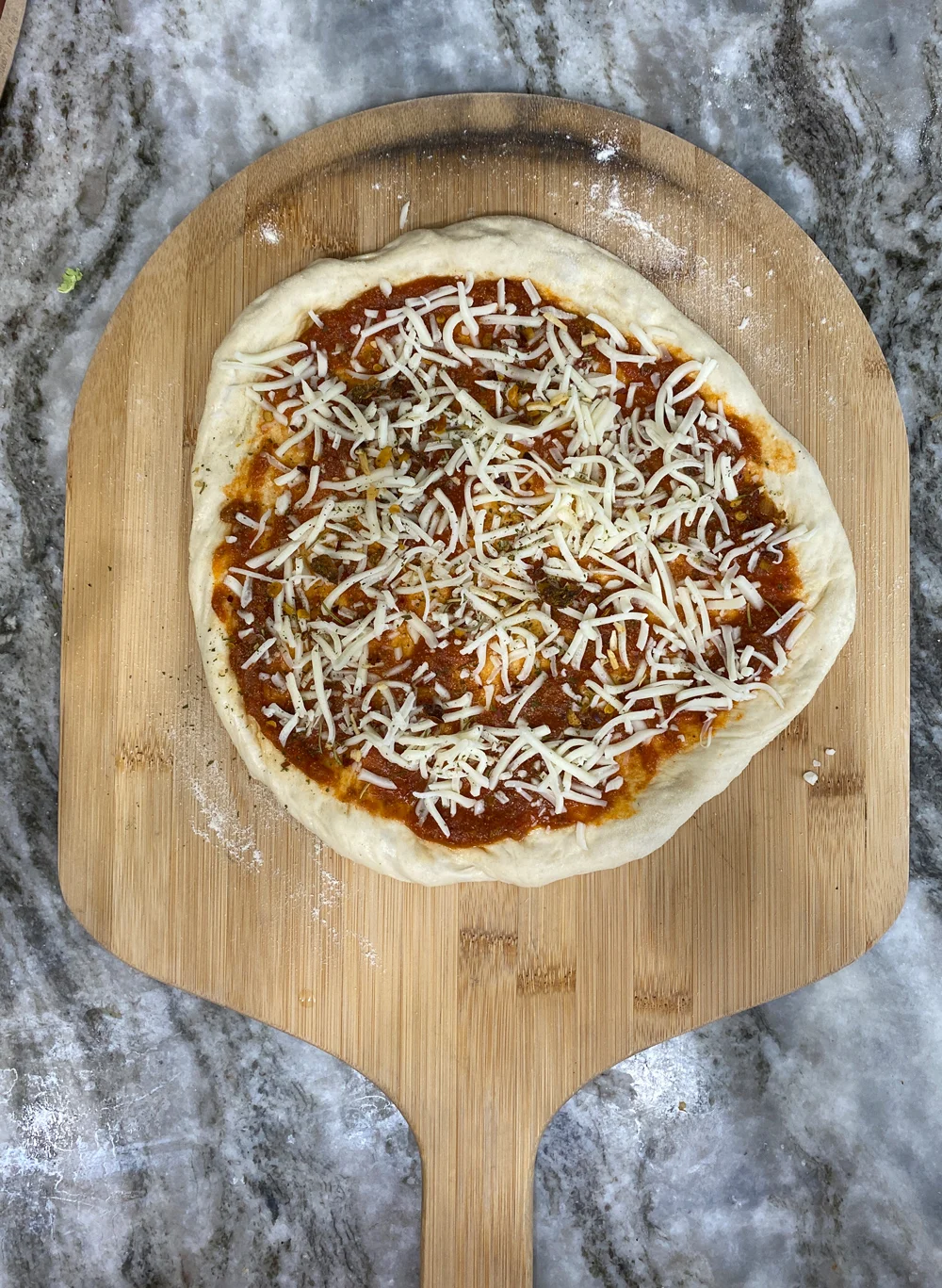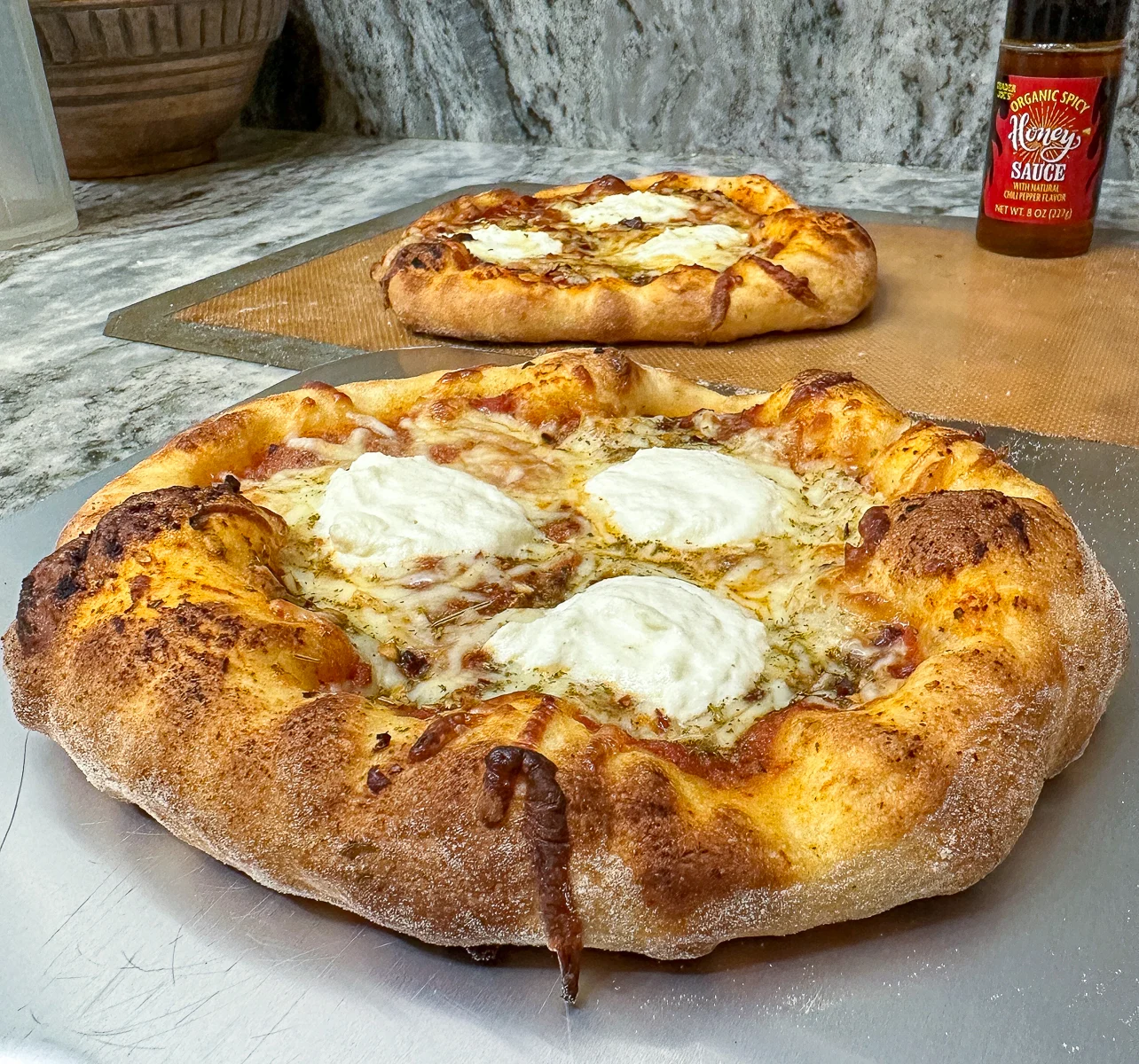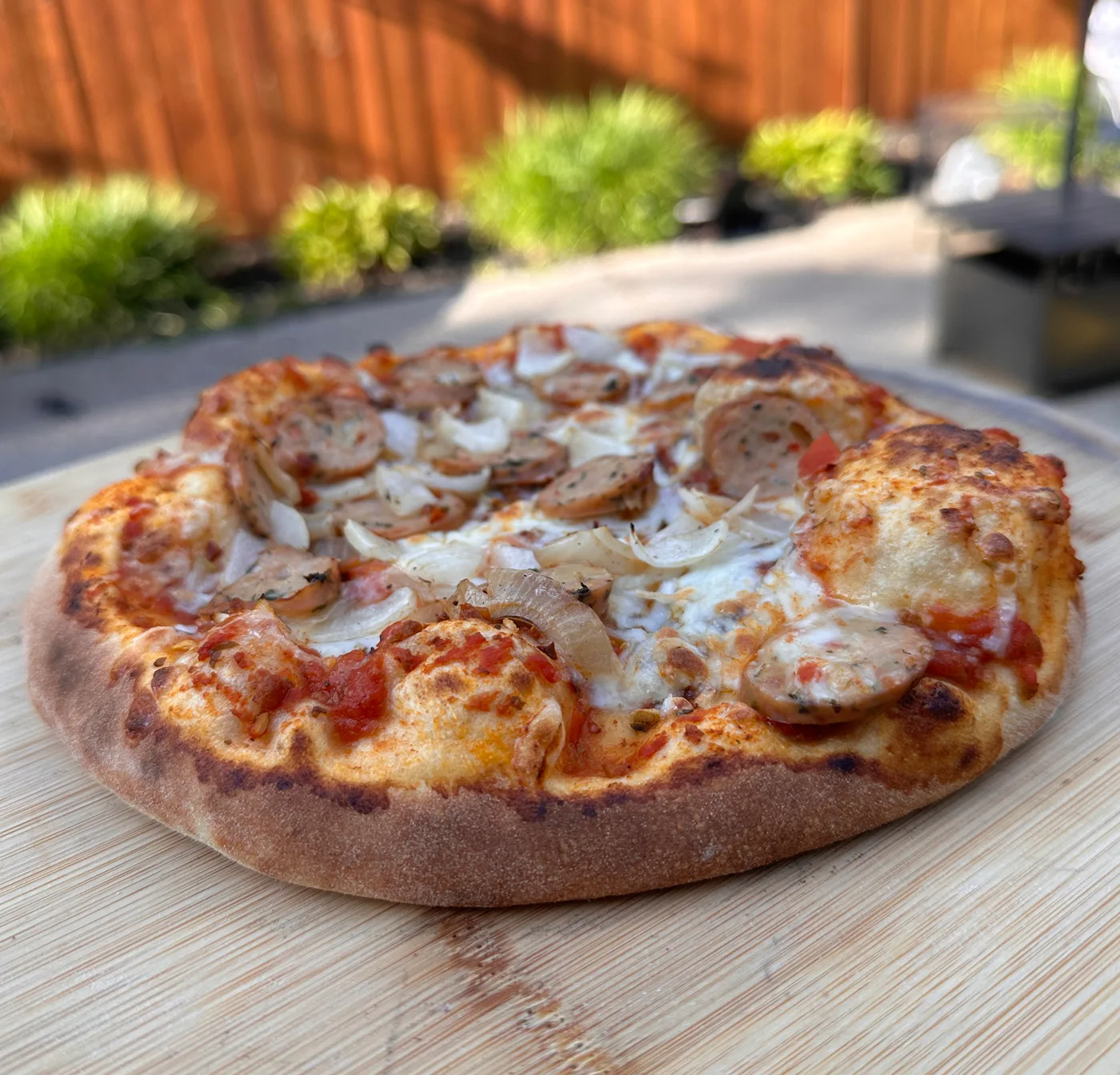If you want to be able to throw together the absolute best homemade pizza, I’m going to show you how to do it with a single shopping trip to Trader Joe’s!
This recipe is in no way sponsored by Trader Joe’s, although that would be lovely. This is my own go-to recipe for homemade pizza that I personally love because Trader Joe’s ingredients are of incredible quality.
You might think that using store-bought pizza dough wouldn’t be as fulfilling as making your own pizza dough, but I’m here to prove you wrong. Trader Joe’s pizza dough is some of the best I’ve had!
By using a single Trader Joe’s Pizza Dough (for about $2) we’re going to make two delicious 10″ pizzas!

If you’re scanning this recipe and thinking “this seems like way too much writing for a simple pizza recipe,” maybe you’re right. But I didn’t want to leave anything to chance here.
I have been making pizza with Trader Joe’s pizza dough for years now, and I like to think I have perfected it. I wanted to include as much detail as possible to help you make the best pizzas of your life.
To help you out, I’ve included a table of contents below so you can jump around to each section of the recipe as needed.
This walkthrough is going to make two 10″ pizzas from one pizza dough, but I’ve more recently started using this same Trader Joe’s pizza dough to make Detroit Style Pizza as well. Check out that recipe if that’s more your style!
Why not follow the Trader Joe’s pizza dough package instructions?
The Trader Joe’s pizza dough contains preparation instructions right on the package, and they certainly work, but they are far from ideal.
Here is what the package recommends:
“Leave dough at room temperature for 20 minutes. Remove dough from package. Flour work surface liberally and roll your dough into a 12″ diameter circle.”
There are three main issues with this that I’m going to help you remedy:
- Trader Joe’s pizza dough is incredibly sticky. As the dough softens at room temperature, it only gets stickier within the plastic, making it very difficult to remove.
- 20 minutes is not long enough to allow the dough to become light and airy. As the dough sits at room temperature, the yeast becomes more active, so a longer time works much better.
- As a fan of thin-crust pizza, I find that making a single 12″ pizza from this Trader Joe’s pizza dough creates a pizza that is far too thick. Instead, we’re going to create two separate 10″ pizzas.
If you’re in a pinch, you can follow Trader Joe’s instructions, but if you want to make the same pizzas I did, keep reading along.
What are the best ingredients for a Trader Joe’s Pizza?
Quality pizza dough is the star, but the toppings you choose for your pizza matter, too!
For this pizza recipe, I love using the Garlic & Herb Trader Joe’s Pizza Dough. It is infused with a ton of amazing flavor, so I love using this particular pizza dough.

Trader Joe’s also sells plain pizza dough, which will work just as well for this recipe. In fact, the two pizza doughs are virtually the same, but this version has an extra garlicky flavor that I really enjoy.
With all that being said, I use these pizza doughs interchangeably, so you may notice photos using one or the other. It’s just a matter of preference (and the availability of what Trader Joe’s has in stock that week).
Regardless of which type you choose, the main ingredients in Trader Joe’s pizza dough are simply enriched flour, water, oil, sugar, salt, and yeast.
Notice how the entire package is one pound, which is more than enough dough for 2 pizzas. If you’re worried about the pizza being too small when split into two, they come to almost the same exact size as my homemade Neapolitan Pizza. A 10″ pizza is the perfect sized meal.
When it comes to toppings, you have the freedom to get as creative as you’d like, but this is what I chose to go with:

Trader Joe’s Bolognese Sauce is my preferred pizza sauce. While Trader Joe’s sells regular pizza sauce, their bolognese is one of my favorite products of theirs. It’s a thick meat sauce with a ton of flavor, and it really takes your pizza to the next level.
Trader Joe’s Lite Mozzarella has been my go-to cheese for quite some time. It’s the only lower-calorie cheese I’ve found that actually melts really, really well. Whenever you use low-fat cheese, not only does the flavor suffer, but it doesn’t melt nearly as well- that’s not the case with this cheese! Plus, I can’t complain about the extra protein it provides, either.
Trader Joe’s Part Skim Ricotta is an excellent addition to the pizza. I often add a few dollops of this ricotta right on top of my pizza, and I love the extra flavor it provides. This is obviously optional, and it can be left out if you prefer to keep calories lower, but it’s a great addition.
Trader Joe’s Italian Style Soffritto Seasoning is my favorite way to season this pizza. You can go with any seasoning you’d like, but this Italian-style seasoning is the perfect compliment to the Trader Joe’s pizza dough.

Hot Honey is relatively new to the market, with Mike’s Hot Honey paving the way. Trader Joe’s recently started selling their own Spicy Honey Sauce, and it has changed pizza forever for me.
I was skeptical about drizzling spicy honey on top of my pizza, but it’s incredible.
While the pizza is still hot, drizzle some Spicy Honey Sauce over the top, and you’ll quickly learn why the combination of hot honey and pizza is so popular. If nothing else, it’s a great way to flavor the crust you’re left with at the very end of your slice.
How to make your own Trader Joe’s pizza
I truly make this exact recipe every single week (we like to celebrate “Pizza Friday” in our household, so if you follow these directions exactly as written, I promise that you’ll end up with absolutely perfect pizza every single time.

Ready to make your own pizza using Trader Joe’s pizza dough? Let’s get into it.
Step 1: Drizzle a little bit of olive oil into the bag of pizza dough.
Trader Joe’s pizza dough is very sticky, so drizzling just a little bit of extra virgin olive oil into the back will make removing it significantly easier.

Step 2: Add the pizza dough to an airtight container and cover.
Flip the pizza dough a few times in the container to make sure it is fully coated in the olive oil, then cover and let sit at room temperature for 4 hours.
Pro tip: If your house is cold, the dough will not rise as much. To ensure the pizza dough rises, you can let it sit in the oven with the pilot light on for 4 hours. I do this very often, and the oven with the light on gives just enough heat to activate the yeast without cooking the dough.
If you don’t plan ahead and do not have 4 hours to spare, that’s totally okay- let the dough sit for one full hour if possible.
The Trader Joe’s pizza dough instructions say to let it size for 20 minutes, but I don’t find that to be nearly long enough.
When you cover the pizza dough and let it sit at room temperature, the yeast will become very active, and the dough will double in size. See the below photo for the before & after…

Step 3: Split the dough into 2 equal-sized balls
After the dough has risen, you’ll split it into 2 separate pieces to make your 2 pizzas.
I like to weigh my pizza dough, then split it in half to get 2 perfectly equal-sized portions. Once split, lightly knead each dough ball for about 30 seconds to smooth them out.

You don’t need to knead the dough balls very much- at this stage, we simply want to smooth them out.
The dough will be pretty sticky, but if you use a silicone mat, it will be very easy to lightly knead. Otherwise, you can use a little bit of semolina flour to help.
Check out this very short video demonstration of my Sourdough Pizza Dough recipe:
Step 4: Wet a towel with warm water, then cover the pizza dough balls for 1 hour.
Washcloths work great, but you can also use paper towels as I have done before (see photo below). Since we split the dough, we want to give each pizza dough ball a chance to rise a little bit more.
If you absolutely have to skip this step, you’ll still have a great pizza crust, but it won’t be quite as airy.

While the dough sits for the final hour, it’s important to preheat your oven.
I use a pizza oven, and I highly recommend investing in one if you plan on having pizza nights often! I have the Ooni Koda 12, which hooks up to a propane tank outside to make things super easy. It’s 12″, so it’s on the smaller side, but it works perfectly for me considering I always make 10″ pizza.
It can reach 700-900 degrees F, which is far hotter than a standard oven, making it ideal for pizza and getting that beautiful char on the crust.
Ooni is definitely one of the better ovens out there, although there are other options as well, so I recommend checking that one out.
If you do not have a pizza oven and are using a regular oven, I can’t recommend using a Pizza Steel enough. Pizza steels create a cooking surface for your pizza that gets insanely hot, allowing the pizza to cook very quickly. Without a pizza oven, using a pizza steel is the next best thing and will produce amazing results.
I like to crank the oven as high as possible (typically 500 degrees F) with the pizza steel or pizza stone in the oven for a full hour, allowing it to get really hot before cooking the pizza. The hotter the surface, the better!
Step 5: Form your 10″ pizzas
There’s nothing I love more than an airy crust (it always feels like hitting the lottery when you get a nice big crust bubble) so we’re going to carefully form each pizza.
First and foremost, sprinkle some semolina flour or cornmeal on your surface and over each ball of dough. Finely ground semolina is the secret ingredient most pizzerias use, and it will help you tremendously when forming your Trader Joe’s pizzas.
Rather than using a rolling pin to roll the pizza out, start by pressing down in the center of the pizza dough, then working your way towards the outer crust. This method helps to keep all of the air inside of the outer crust, which is what we want.

After you do this, you’ll pick up the pizza by hooking your fingers under the outer crust. You’ll slowly turn the pizza like a wheel, allowing gravity to stretch the pizza into shape.

Once stretched out, you should have a pizza that is right around 10 inches.

I form my pizza on this Silicone Pizza Mat that measures the pizza for you, which makes things very easy.
The exact size may vary, but I always aim to make my pizzas as close to 10″ as possible. If you don’t want as big of an outer crust on your pizza, you can stretch each pizza to 12″ with a smaller crust.

My goal is always to have some air bubbles in my crust like you see above, because that leads to those wonderfully charred bubbles that everybody loves.
Step 6: Place on a pizza peel and add your toppings
Sprinkle some semolina flour or cornmeal on a wooden pizza peel and transfer your pizza dough onto the peel. If you add the pizza dough to the pizza peel on its own, it will not slide off, so it’s important to use semolina or cornmeal.
Once the formed pizza dough is on the pizza peel, give it a little shake to make sure the pizza moves around and will be able to easily slide off the pizza peel. If it doesn’t budge, lift up the crust to sprinkle more semolina underneath until you’re able to slide it around.
At this point, you’re ready to top your pizza with whatever Trader Joe’s toppings you’d like!
However, it’s important to note that you don’t want to get too heavy-handed with the toppings- a little goes a long way. Since this is thin-crust pizza, loading up the pizza with tons of heavy toppings is not going to work in your favor.

I simply spread a layer of Trader Joe’s Bolognese sauce on the pizza, then top with shredded mozzarella and soffrito seasoning.
While this may not seem like a ton of cheese, it actually melts down into a perfect amount, so you don’t need to worry about completely covering the entire pizza with shredded mozzarella.
Step 7: Cook your Trader Joe’s pizza
Now for the fun part: cooking your pizza! You’ve waited hours for the dough to rise, so now it’s time for you to be rewarded.
Cooking Option 1: Pizza oven
If you’re using a pizza oven as I do (I cannot recommend the Ooni enough), this pizza will cook in a matter of minutes.

My pizza oven cooking tip: I crank the heat as high as possible while the oven is preheating in order to get the pizza stone to the highest temperature possible. This ensures that the bottom of the pizza will become nice and charred. However, right before putting the pizza in the oven, I turn the temperature to low so the outer crust does not burn. This strategy has worked great for me!
Carefully slide your pizza into your pizza oven, then rotate your pizza every 15-20 seconds. Since the flame is located in the back of the oven, if you let the pizza sit too long without moving it, the back side will completely burn.

It’s better to turn the pizza too often than not often enough. If the crust isn’t quite browned enough, you can always rotate it back!
All in all, this pizza will be completely cooked in a matter of minutes, so make sure you don’t step away.
You’ll achieve a delicious result in a standard oven, but a pizza oven is worth the investment. Because of my pizza oven, “Pizza Friday” has become a weekly staple in our household.

Cooking Option 2: Traditional oven
You don’t need a fancy pizza oven to make delicious pizza at home! While I recommend it, you can still achieve a beautiful crust in your own kitchen with no special equipment.
If you’re using a regular oven, I highly recommend you buy either a pizza stone or pizza steel to create a very hot surface to crisp the bottom of your pizza. Since regular ovens don’t get as hot as pizza ovens, using a pizza stone allows the bottom to crisp up very nicely.
However, you don’t even need a pizza stone! If you have absolutely no equipment, you can use a baking sheet to achieve a wonderful result.
Flip a baking sheet upside down, then place another baking sheet on the rack directly above it. This will create a ton of heat between the 2 baking sheets, giving you a perfect surface to bake your pizza.

Crank the heat as high as possible (usually 500 to 525 degrees F) and let your oven preheat for 45 minutes to 1 hour. Preheating is extremely important to get your surface as hot as possible! Without preheating, the top of your crust will cook much faster than the bottom, leading to a much flatter (and often overcooked) result.
Yes, your kitchen might get pretty hot in this time, but it’s worth it!
Once the oven is hot and ready, prep your pizza on a pizza peel with some semolina or corn meal so the pizza can easily slide off, then slide the pizza right onto the upside-down baking sheet (or pizza stone if you go that route).
You may need to rotate the pizza halfway through, but since there is no direct flame like with a pizza oven, it’s not quite as necessary.
The entire pizza should cook in 10-15 minutes, but it will vary based on your oven, so keep an eye on it as it cooks to pull it once it looks ready.
Even with a regular oven, you’ll be able to achieve a wonderfully airy, charred pizza crust. Check out the pizza I was able to make in my oven with just a baking sheet:

For a pizza made in a traditional oven, I am extremely impressed!
I like to top my pizza with some Trader Joe’s Spicy Honey Sauce once I remove the pizza from the oven, and it’s the perfect finishing touch. It may sound odd, but the combination may just change your life if you haven’t tried it.
Otherwise, saving a little extra Trader Joe’s Bolognese (or other sauce) to dip the crust into is an excellent strategy.
If you don’t have a Trader Joe’s near you, first of all, I sincerely apologize. Second of all, you can follow these same instructions using any store-bought pizza dough you can find!

How To Make Trader Joe’s Pizza With Zero Prep Time
Recently, we found ourselves up against it for dinner and had our hearts set on pizza. We didn’t want to settle for takeout, so I decided to see what would happen if I took the pizza dough out of the fridge and immediately cooked it.
The instructions on the package say to let the dough sit for 20 minutes at room temperature before making your pizza, but for my experiment, I wanted to pull it directly out of the fridge with zero waiting time.
First things first: preheat your oven. Whether you’re using a traditional oven or a pizza oven, fire it up while you form your pizzas (see the above section for instructions for each cooking method). For pizza ovens, it will be much shorter than a traditional preheat, but you should still get about 15 minutes while you form the pizzas.
Remove the pizza dough from the fridge, split it into two, and then get to work forming the pizzas.
Since the dough is cold and tough, you won’t be able to form the pizza with your hands. Instead, you’ll have to use a rolling pin to roll it out thin.
Even though this isn’t my preferred method, I was still able to stretch the pizza to roughly 10″ in diameter.

You won’t be able to accomplish forming a thick outer crust, but depending on your cooking method, that might not be the end of the world.
Top the pizza with your favorite toppings, then slide it into your hot oven.
If you’re using a pizza oven (which I cannot recommend enough), the outer crust should still puff up plenty.

Honestly, I was surprised at just how much it did puff up. Considering I needed to use a rolling pin to roll the dough out flat, I was not expecting it to be this airy, but that’s the beauty of a pizza oven! The high heat of the pizza stone and direct flame work like magic.
If you use a traditional oven, don’t expect these results- your pizza will become more of a NY-style pizza instead, which is not necessarily a bad thing.
So, how was the final result? Honestly, it came out much better than I expected.

But don’t be fooled: looks aren’t everything.
With no real preheat on my oven, my pizza was still pretty doughy, so I needed to toss it into my kitchen oven for about 10 minutes at a low temperature to finish cooking through.
But more importantly, you’ll notice a big difference in the outer crust. While it’s still nice and puffy, it is significantly denser than when we let the dough sit out at room temperature.
If you’re in a pinch, you can definitely make this work. But there’s a reason I wrote such a long recipe for this Trader Joe’s pizza: because it comes out really, really good.
I definitely recommend following the full instructions for best results (both in terms of texture and flavor), but if you’re facing a pizza emergency, this is not a bad fallback.
More Trader Joe’s Inspired Recipes
It’s no secret that I absolutely love Trader Joe’s. In fact, I love it so much that I put together a full guide that includes the nutrition facts for over 600 Trader Joe’s products. It is absolutely worth checking out.
I also have some other recipes here on my blog that revolve around Trader Joe’s ingredients, so you can plan to make multiple recipes from your next shopping trip!
And many more to come!
Trader Joe’s Pizza Recipe
Ingredients
- 1 Package Trader Joe’s Pizza Dough (Original or Garlic & Herb)
- 1/2 Cup Trader Joe’s Bolognese Sauce (Can use pizza sauce as well)
- 1 Cup Trader Joe’s Shredded Lite Mozzarella Cheese
- Optional: 1/2 Cup Trader Joe’s Part Skim Ricotta Cheese
- Trader Joe’s Italian-Style Soffritto Seasoning
- Spicy Honey Sauce for Drizzle
Instructions
- Pour a small amount of olive oil into the bag of pizza dough (roughly 1 tablespoon, but I did not measure) to help make the pizza dough easier to remove.
- Add the Trader Joe’s pizza dough to an airtight container and flip it over a few times to spread the olive oil around the entire dough ball.
- Cover and let sit at room temperature for 4 hours. Note that you don’t need to let it sit for this long, but I highly recommend an hour at a minimum (the 20 minutes recommended time on the package is not enough for an airy crust).
- Split the dough into 2 equal-sized dough balls, then knead each ball for about 30 seconds to smooth them out. Wet a towel with warm water and cover the dough balls for 1 more hour.
- While the dough sits for the final hour, preheat your pizza oven at its highest heat setting, or preheat your kitchen oven at the highest temperature (usually 500 degrees F) with a pizza stone or pizza peel. If you do not have a pizza stone, you can flip a baking sheet upside down and use that as your hot surface and it works surprisingly well.
- After the hour, shape your pizzas. Press out towards the crust to keep air in the crust, then pick up the pizza dough with your fingers hooked under the crust, allowing the weight of gravity to stretch the dough. You should be able to form two 10″ pizzas from your dough.
- Sprinkle some semolina flour (or cornmeal) on a pizza peel and add your formed pizza dough to it. Give the pizza peel a quick shake to make sure the dough moves around. If it’s sticking, be sure to add additional semolina flour.
- Top with sauce, cheese, and whatever other toppings you’d like, being careful not to add too many toppings as this is a thin pizza.
- For pizza oven: If using a pizza oven (like the Ooni), I like to turn the temperature to low just before adding the pizza to make sure the flame is not too high to burn the pizza. Slide the pizza into the oven and rotate the crust every 15 seconds to make sure each side does not burn. Continue until the entire pizza is cooked to your liking, which should only take a couple of minutes.
- For regular oven: Slide the pizza off the peel and onto your hot pizza stone or baking sheet, then bake to your liking. The pizza should only take about 10 minutes, but monitor the pizza and pull it from the oven when it is cooked the way you like it, as oven temperatures can vary quite a bit and affect the cooking time.
- Follow the same instructions for your second pizza.
- Drizzle with some Trader Joe’s Spicy Honey Sauce, then slice and enjoy!
Notes
- Pizza oven cooking tip: I crank the heat as high as possible, then turn it down low just before adding my pizza. Once the pizza is done, remove it from the oven and crank the heat as high as possible once more before cooking your second pizza. This will help make sure the oven is hot enough to crisp up your second pizza, too.
- Using a traditional oven with no pizza stone: Flip a baking sheet upside down in your oven, then place another baking sheet on the rack directly above it to create a lot of heat between the two. Preheat the oven to 500 degrees for 1 hour to allow the baking sheets to get as hot as possible. See the notes above this recipe card for a photo of how my pizza turned out using this process- I was very impressed!
- The Trader Joe’s Pizza Dough contains 560 calories if you form 2 pizzas from a single dough as I did in this recipe. Otherwise, the entire pizza will have over 1,100 calories in the crust alone.
- You don’t have to let your pizza dough sit for 4 hours, but that amount of time works great for me. At a certain point, longer doesn’t necessarily equal better, but you won’t be causing any harm by letting the pizza rest and rise at room temperature. Aim for at least one hour.
- If you have pizza dough in your freezer, let it thaw in the fridge overnight the day before you plan on making your pizza, or you can pull the dough from the freezer and leave it out at room temperature for about 1 hour to thaw. Then follow this recipe exactly the same way. The pizza turns out great, but I’ve found that it doesn’t get nearly as airy once frozen.
Recommended Products
As an Amazon Associate and member of other affiliate programs, I earn from qualifying purchases.
Nutrition Information
Yield 2
Serving Size Entire 10″ Pizza (With All Toppings)
Amount Per Serving
Calories 720Total Fat 16gCarbohydrates 110gProtein 36g





